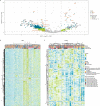Ultra High-plex Spatial Proteogenomic Investigation of Giant Cell Glioblastoma Multiforme Immune Infiltrates Reveals Distinct Protein and RNA Expression Profiles
- PMID: 37377888
- PMCID: PMC10155752
- DOI: 10.1158/2767-9764.CRC-22-0396
Ultra High-plex Spatial Proteogenomic Investigation of Giant Cell Glioblastoma Multiforme Immune Infiltrates Reveals Distinct Protein and RNA Expression Profiles
Abstract
A deeper understanding of complex biological processes, including tumor development and immune response, requires ultra high-plex, spatial interrogation of multiple "omes". Here we present the development and implementation of a novel spatial proteogenomic (SPG) assay on the GeoMx Digital Spatial Profiler platform with next-generation sequencing readout that enables ultra high-plex digital quantitation of proteins (>100-plex) and RNA (whole transcriptome, >18,000-plex) from a single formalin-fixed paraffin-embedded (FFPE) sample. This study highlighted the high concordance, R > 0.85 and <15% change in sensitivity between the SPG assay and the single-analyte assays on various cell lines and tissues from human and mouse. Furthermore, we demonstrate that the SPG assay was reproducible across multiple users. When used in conjunction with advanced cellular neighborhood segmentation, distinct immune or tumor RNA and protein targets were spatially resolved within individual cell subpopulations in human colorectal cancer and non-small cell lung cancer. We used the SPG assay to interrogate 23 different glioblastoma multiforme (GBM) samples across four pathologies. The study revealed distinct clustering of both RNA and protein based on pathology and anatomic location. The in-depth investigation of giant cell glioblastoma multiforme (gcGBM) revealed distinct protein and RNA expression profiles compared with that of the more common GBM. More importantly, the use of spatial proteogenomics allowed simultaneous interrogation of critical protein posttranslational modifications alongside whole transcriptomic profiles within the same distinct cellular neighborhoods.
Significance: We describe ultra high-plex spatial proteogenomics; profiling whole transcriptome and high-plex proteomics on a single FFPE tissue section with spatial resolution. Investigation of gcGBM versus GBM revealed distinct protein and RNA expression profiles.
© 2023 The Authors; Published by the American Association for Cancer Research.
Figures







References
-
- Liu Y, Beyer A, Aebersold R. On the dependency of cellular protein levels on mRNA abundance. Cell 2016;165:535–50. - PubMed
MeSH terms
Substances
LinkOut - more resources
Full Text Sources
Medical

